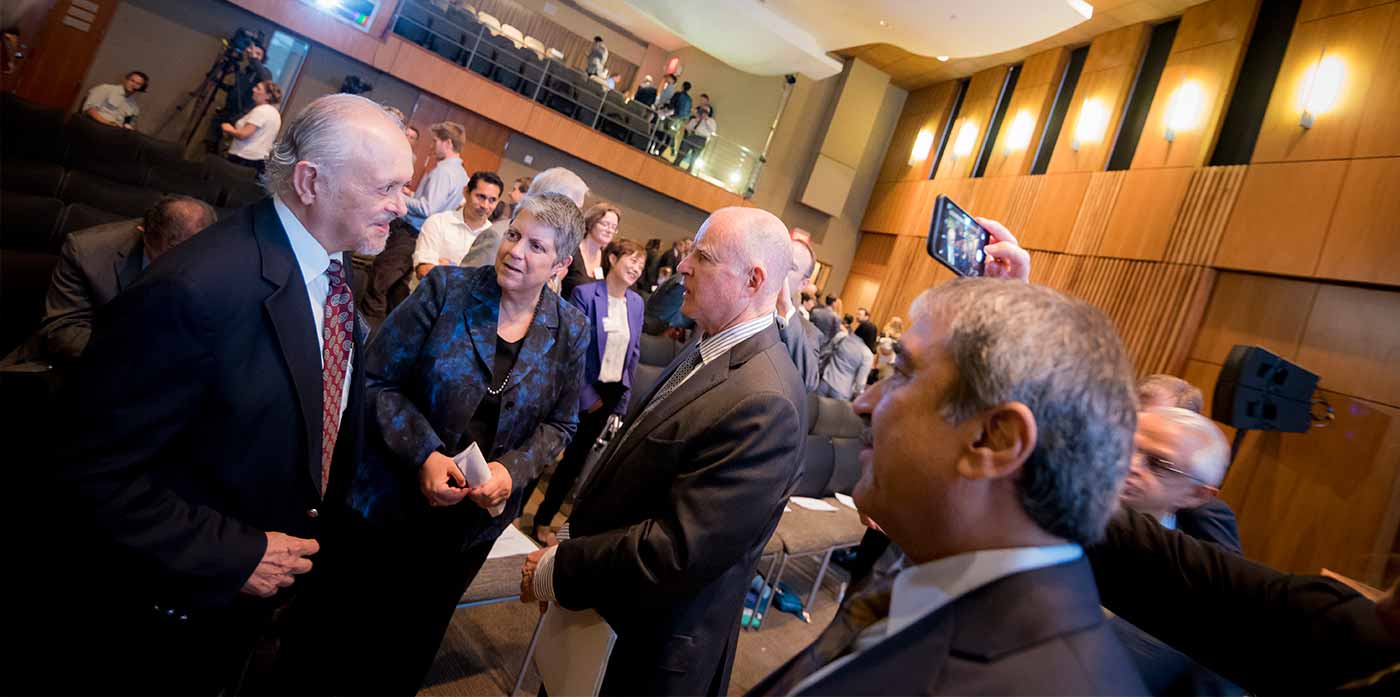UC Researchers Present 10 Scalable Solutions for Climate Change
Published Date
By:
- Laura Margoni
Share This:
Article Content

Nobel Laureate and Distinguished Professor Mario Molina, UC President Janet Napolitano, California Governor Jerry Brown and Chancellor Khosla. Photo by Erik Jepsen/UC San Diego Publications
University of California climate and energy experts announced 10 scalable solutions for moving the world towards carbon neutrality, a practical framework that outlines both immediate and longer-term actions for staving off catastrophic climate change. The solutions were announced during the UC Summit on Carbon and Climate Neutrality that was held at UC San Diego Oct. 26-27.
Gov. Jerry Brown, who joined UC President Janet Napolitano at the summit, said the solutions from the UC Climate Solutions Group could help shape talks among global leaders at the United Nations Conference on Climate Change in Paris this November.
“This is a call to action. We put all of our best minds in California on this – a very formidable force. Nothing less than that is required,” said Brown.
The effects of global warming already are beginning to wreak havoc around the world, with direct impact on human lives. Napolitano called it one of the greatest security challenges the world faces.
“Climate change impacts issues as varied as disease management, food security, the preservation of water resources, the stability of fragile governments, and transportation infrastructure,” said Napolitano. “Addressing these challenges, and reducing our carbon footprint, is a moral imperative.”
The UC Climate Solutions Group, composed of 50 top experts from all 10 UC campuses and the associated national laboratories, also stressed the moral implications of climate change in the executive summary of their report, “Bending the Curve: Ten scalable solutions for carbon neutrality and climate stability,” highlighting that the people most at risk are the world’s 3 billion poorest people, while the majority of pollution is created by the wealthiest 1 billion.
“Fifteen percent of us contribute 60 percent of the pollution. We’re leaving behind a planet of uncertain future for our children, grandchildren and generations unborn,” said Veerabhadran Ramanathan, chair of the UC Climate Solutions Group, and a renowned climate scientist from Scripps Institution of Oceanography at UC San Diego.
The summary report emphasizes that action on climate change is urgently needed, and that we already have the tools to slow global warming in the short-term. Taking immediate action will afford us the time needed to put in place the emerging technologies and make the cultural shifts that will allow the world to transition to a carbon-neutral future.
Recognizing that climate change is as much a technical challenge as it is a cultural, political and communications challenge, the solutions address the science and technology as well as the societal, regulatory and ecosystem approaches that will need to be brought to bear in the war on climate change.
Key points from the executive summary include:
- Target short-lived climate pollutants. Short-lived climate pollutants (SLCPs), which include methane, black carbon, HFCs and ozone. Unlike CO2, emissions of SLCPs can be cut back quickly, slowing warming in the near term.
- Immediately scale up the technology we have. Solar and wind power, electric light-duty vehicles, and efficient devices, particularly for lighting, air conditioning and industrial processes, are ready for widespread use now.
- Religious and Community leaders are vital allies. Because fundamental changes in attitudes and behaviors are critical, solutions must bring researchers and scholars together with community and religious leaders to lower barriers and create a culture of climate action to take concrete steps toward solving our shared climate crisis.
- Reduce emissions from the wealthiest, empower the poorest. Climate action requires lowering the carbon footprint of the wealthiest 1 billion (who contribute roughly 60 percent of the climate pollution), while promoting clean energy for the poorest 3 billion, who will suffer the worst consequences of climate disruption.
- Health impacts are happening today. Climate change is affecting human health right now. Burning fossil fuels causes both air pollution and climatic events that result in human illnesses and death as well as significant loss of food crops and water.
- California is a model for the world. California’s economic growth and success with governance, regulations, market-based instruments and promotion of national to international climate action plans, as well as technologies developed by UC and tested in living laboratories throughout the state, can serve as a model for other parts of the world.
The full “Bending the Curve” Executive Summary can be found here.
The summit is part of President Napolitano’s Carbon Neutrality Initiative announced in 2013, in which the University of California pledged to become carbon neutral by 2025 – the first major research university to reach that goal. The state of California has its own ambitious climate targets: Reduce carbon dioxide emissions to 40 percent below 1990 levels, shift California’s electricity production to at least 50 percent renewable sources, and increase building energy efficiency by 50 percent – all by 2030.
Learn more about the summit here.
Share This:
You May Also Like
Stay in the Know
Keep up with all the latest from UC San Diego. Subscribe to the newsletter today.



